软件逆向-针对百度旗下的一个会议软件,简单研究其CEF框架
推荐 原创一、前言
前段时间在论坛上看到了研究钉钉CEF框架的帖子,认真看完了,受益匪浅:https://bbs.pediy.com/thread-274198.htm
于是我也想找一个CEF框架的应用,用同样的思路去实践一下。正好这两天面试百度,面试会议软件用的是它们自己做的“如流”,恰好也是CEF框架,你说这不巧了嘛。还真是缘分呐~
二、初步环境准备
由于后面需要用到hook手段,所以这里最好是把对应版本的cef库从官网给下载下来,如此一来,相关的结构体、类、成员的声明就不需要我们自己做了。首先打开如流安装目录下的cef目录,打开libcef.dll的属性
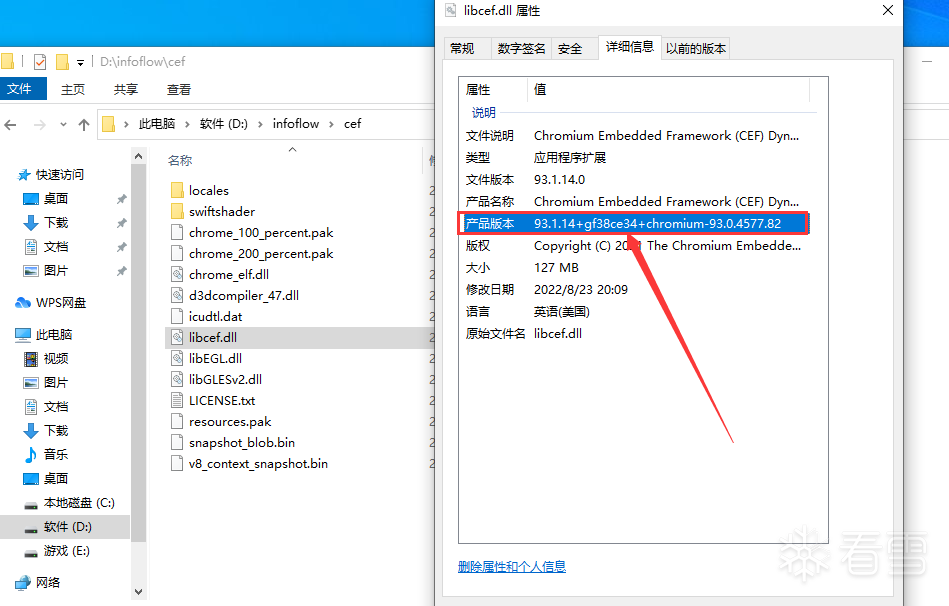
去官网找对应的libcef+chromium版本即可:https://cef-builds.spotifycdn.com/index.html下载框架

在windows上下载好后,直接解压即可
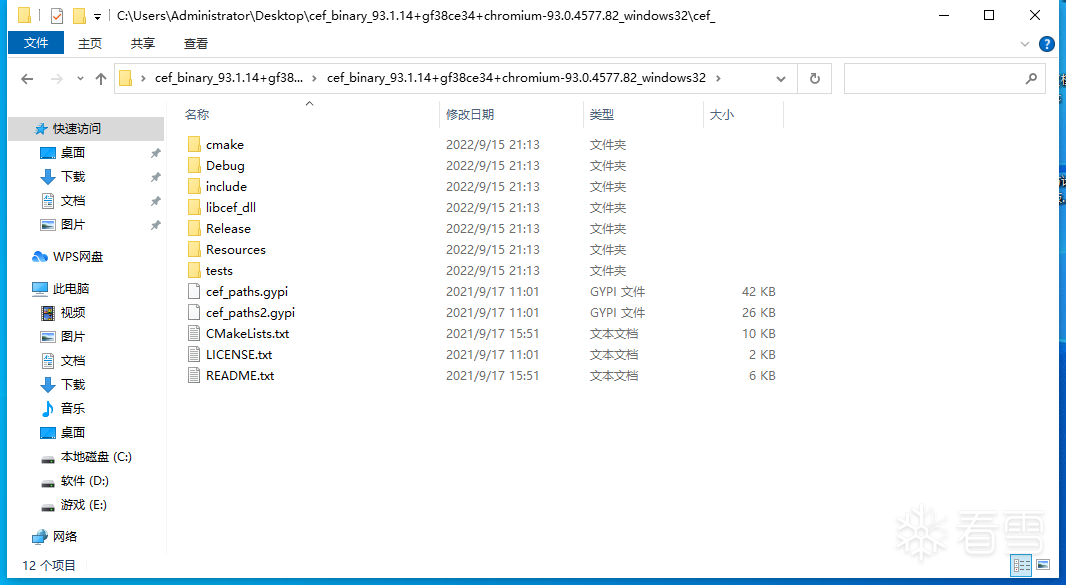
后面还要用到detours进行api的hook,所以把detours也装一下,顺便学习学习detours咋用:https://www.lmlphp.com/user/65200/article/item/640921/
三、找到js资源文件所在
根据参考帖,我们要在应用登录前,选择这两个函数下断点
cef_stream_reader_create_for_data
cef_stream_reader_create_for_file
本来想打开如流,然后用OD附加进程来着,结果各种问题,干脆直接以启动方式打开调试,先F9让它跑起来,等登录界面出来,在libcef.dll模块里的两个函数下断点(记得程序是这个infoflow.exe,别调成了iLauncher.exe,这是个启动器)
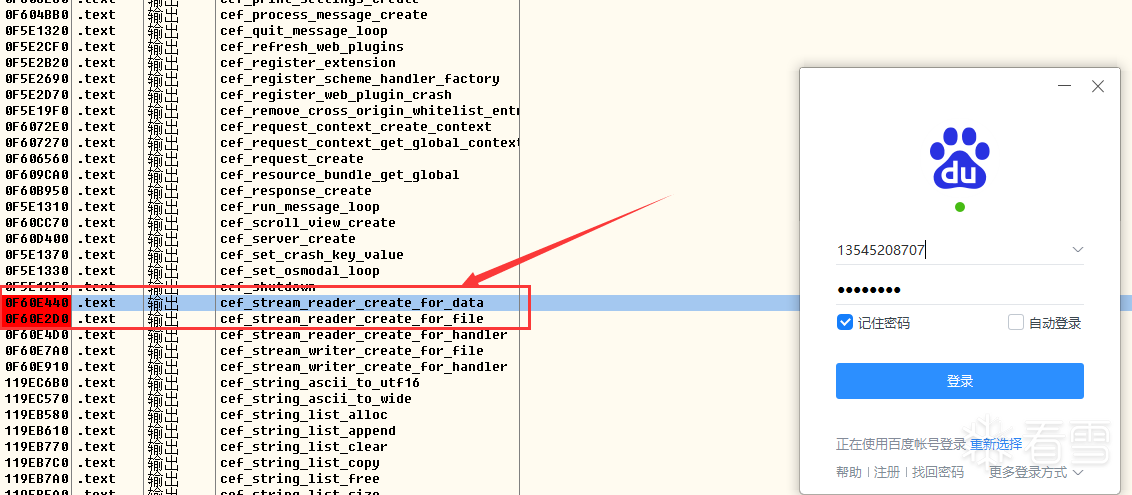
然后输入自己的账户密码登录,登录成功后,过了一会断点才来,经过测试,发现断点只断这么一次。根据寄存器ECX~EDI的值定位到内存,发现多个资源路径(所有寄存器对应内存都看一下)
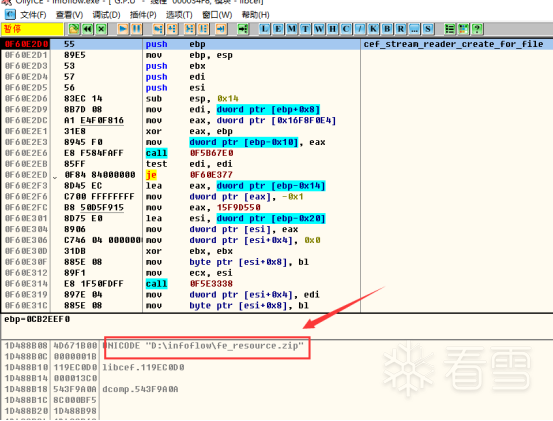
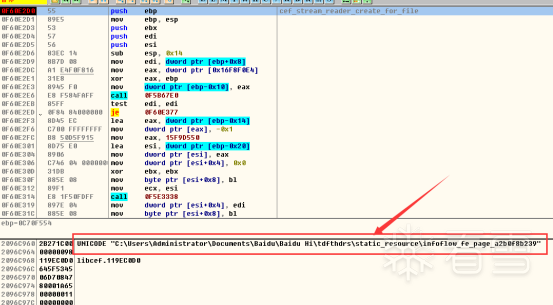
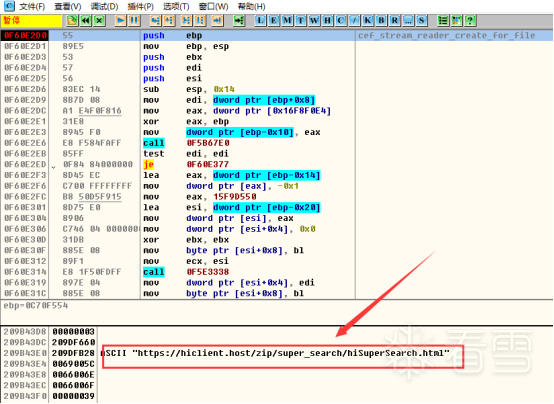
第二张和第三张图片可以省略,因为这俩资源文件在第一张路径里都有,找到第一张的路径,发现是个加密的zip
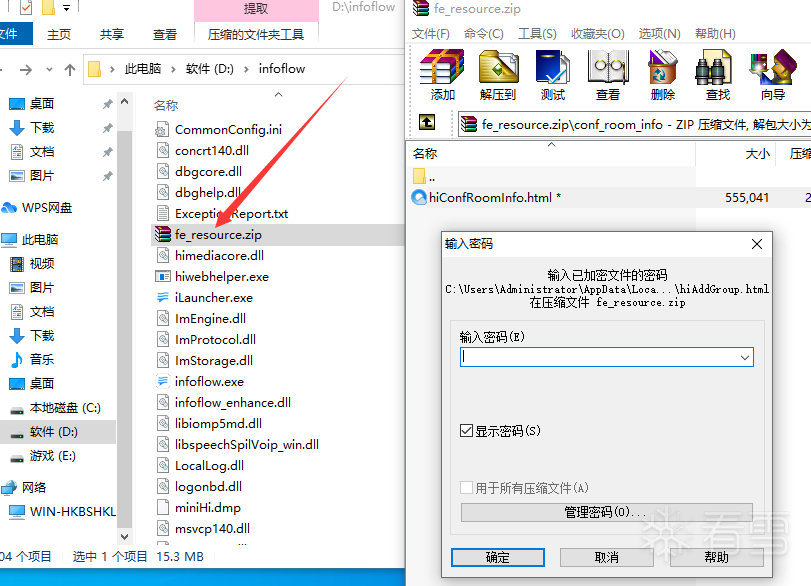
四、解密资源文件
程序运行时肯定会在某个时机解密数据,我们在相关API处下断点,逆向分析即可得到密码。这里根据参考帖子,也是从CEF框架的API入手
cef_zip_directory 写数据到zip文件
cef_zip_reader_create从zip文件读取数据
我们想要拿解压缩密码的话,重点从结构体cef_zip_reader_t中的openfile成员函数的参数进行获取。
函数声明和相关结构体声明
|
1
2
3
4
5
6
7
8
9
10
11
12
13
14
15
16
17
18
19
20
21
22
23
24
25
26
27
28
29
30
31
32
33
34
35
36
37
38
39
40
41
42
43
44
45
46
47
48
49
50
51
52
53
54
55
56
57
58
59
60
61
62
63
64
65
66
67
68
69
70
71
72
73
74
75
76
77
78
79
80
81
82
83
84
85
86
87
88
89
90
91
92
93
94
95
96
97
98
99
100
101
102
103
104
105
106
107
108
109
110
111
112
113
114
115
116
117
118
119
120
121
122
123
124
125
126
127
128
129
130
131
132
133
134
135
136
137
138
139
140
|
/
/
/
/
/
All
ref
-
counted framework structures must include this structure first.
/
/
/
typedef struct _cef_base_ref_counted_t {
/
/
/
/
/
Size of the data structure.
/
/
/
size_t size;
/
/
/
/
/
Called to increment the reference count
for
the
object
. Should be called
/
/
for
every new copy of a pointer to a given
object
.
/
/
/
void(CEF_CALLBACK
*
add_ref)(struct _cef_base_ref_counted_t
*
self
);
/
/
/
/
/
Called to decrement the reference count
for
the
object
. If the reference
/
/
count falls to
0
the
object
should
self
-
delete. Returns true (
1
)
if
the
/
/
resulting reference count
is
0.
/
/
/
int
(CEF_CALLBACK
*
release)(struct _cef_base_ref_counted_t
*
self
);
/
/
/
/
/
Returns true (
1
)
if
the current reference count
is
1.
/
/
/
int
(CEF_CALLBACK
*
has_one_ref)(struct _cef_base_ref_counted_t
*
self
);
/
/
/
/
/
Returns true (
1
)
if
the current reference count
is
at least
1.
/
/
/
int
(CEF_CALLBACK
*
has_at_least_one_ref)(struct _cef_base_ref_counted_t
*
self
);
} cef_base_ref_counted_t;
/
/
/
/
/
Structure that supports the reading of
zip
archives via the zlib unzip API.
/
/
The functions of this structure should only be called on the thread that
/
/
creates the
object
.
/
/
/
typedef struct _cef_zip_reader_t {
/
/
/
/
/
Base structure.
/
/
/
cef_base_ref_counted_t base;
/
/
/
/
/
Moves the cursor to the first
file
in
the archive. Returns true (
1
)
if
the
/
/
cursor position was
set
successfully.
/
/
/
int
(CEF_CALLBACK
*
move_to_first_file)(struct _cef_zip_reader_t
*
self
);
/
/
/
/
/
Moves the cursor to the
next
file
in
the archive. Returns true (
1
)
if
the
/
/
cursor position was
set
successfully.
/
/
/
int
(CEF_CALLBACK
*
move_to_next_file)(struct _cef_zip_reader_t
*
self
);
/
/
/
/
/
Moves the cursor to the specified
file
in
the archive. If |caseSensitive|
/
/
is
true (
1
) then the search will be case sensitive. Returns true (
1
)
if
the
/
/
cursor position was
set
successfully.
/
/
/
int
(CEF_CALLBACK
*
move_to_file)(struct _cef_zip_reader_t
*
self
,
const cef_string_t
*
fileName,
int
caseSensitive);
/
/
/
/
/
Closes the archive. This should be called directly to ensure that cleanup
/
/
occurs on the correct thread.
/
/
/
int
(CEF_CALLBACK
*
close)(struct _cef_zip_reader_t
*
self
);
/
/
The below functions act on the
file
at the current cursor position.
/
/
/
/
/
Returns the name of the
file
.
/
/
/
/
/
The resulting string must be freed by calling cef_string_userfree_free().
cef_string_userfree_t(CEF_CALLBACK
*
get_file_name)(
struct _cef_zip_reader_t
*
self
);
/
/
/
/
/
Returns the uncompressed size of the
file
.
/
/
/
int64(CEF_CALLBACK
*
get_file_size)(struct _cef_zip_reader_t
*
self
);
/
/
/
/
/
Returns the last modified timestamp
for
the
file
.
/
/
/
cef_basetime_t(CEF_CALLBACK
*
get_file_last_modified)(
struct _cef_zip_reader_t
*
self
);
/
/
/
/
/
Opens the
file
for
reading of uncompressed data. A read password may
/
/
optionally be specified.
/
/
/
int
(CEF_CALLBACK
*
open_file)(struct _cef_zip_reader_t
*
self
,
const cef_string_t
*
password);
/
/
/
/
/
Closes the
file
.
/
/
/
int
(CEF_CALLBACK
*
close_file)(struct _cef_zip_reader_t
*
self
);
/
/
/
/
/
Read uncompressed
file
contents into the specified
buffer
. Returns <
0
if
/
/
an error occurred,
0
if
at the end of
file
,
or
the number of bytes read.
/
/
/
int
(CEF_CALLBACK
*
read_file)(struct _cef_zip_reader_t
*
self
,
void
*
buffer
,
size_t bufferSize);
/
/
/
/
/
Returns the current offset
in
the uncompressed
file
contents.
/
/
/
int64(CEF_CALLBACK
*
tell)(struct _cef_zip_reader_t
*
self
);
/
/
/
/
/
Returns true (
1
)
if
at end of the
file
contents.
/
/
/
int
(CEF_CALLBACK
*
eof)(struct _cef_zip_reader_t
*
self
);
} cef_zip_reader_t;
/
/
/
/
/
Writes the contents of |src_dir| into a
zip
archive at |dest_file|. If
/
/
|include_hidden_files|
is
true (
1
) files starting with
"."
will be included.
/
/
Returns true (
1
) on success. Calling this function on the browser process UI
/
/
or
IO threads
is
not
allowed.
/
/
/
CEF_EXPORT
int
cef_zip_directory(const cef_string_t
*
src_dir,
const cef_string_t
*
dest_file,
int
include_hidden_files);
/
/
/
/
/
Create a new cef_zip_reader_t
object
. The returned
object
's functions can
/
/
only be called
from
the thread that created the
object
.
/
/
/
CEF_EXPORT cef_zip_reader_t
*
cef_zip_reader_create(
struct _cef_stream_reader_t
*
stream);
|
那么我就有思路了,首先断点只会断一次,所以我们不需要考虑解密函数的参数变化问题,因为它只会解密这一个zip,因此我的思路如下:
1.在cef_zip_reader_create下断点
2.命中断点后,执行到返回,返回值就是cef_zip_reader_t结构体的指针

3.拿到指针地址,咱们就拿到了openfile函数的地址
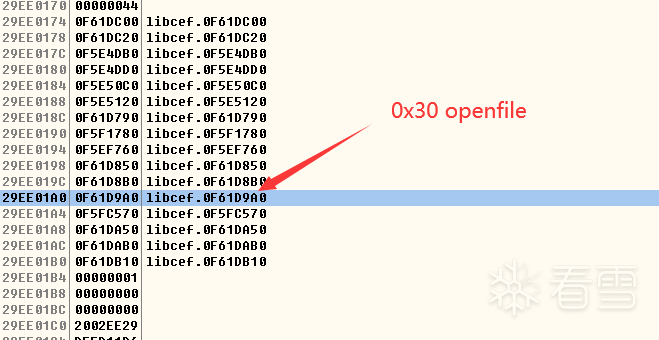
4.在openfile函数下断点,断点命中后,直接在栈上看第二个参数即可(如果不确定人家的调用约定的话,那就也看看寄存器,万一是fastcall呢~~)
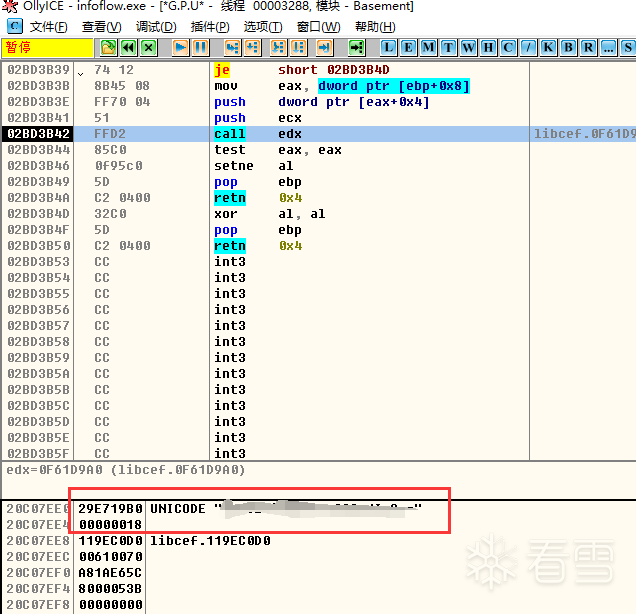
最终在第二个参数拿到了一串字符串,作为密码,成功解压!(密码就不展示了)里面包含了挺多功能:添加联系人、搜索、设置等等相关的html和js资源。
所以目前我对CEF框架应用的一个理解,大概是它们的界面、操作等等代码都是用html、js语言去实现的,相当于把一个在线网页做成了客户端(难怪以前用OD咋都断不到MessageBox,合着人家压根就没用C++实现,终于明白了~)
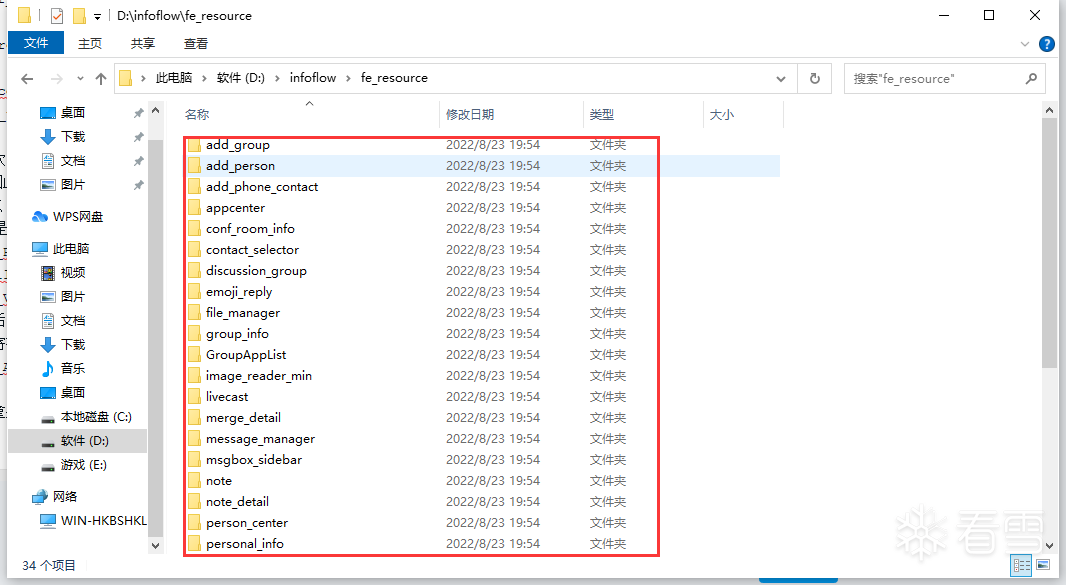
我们如果想对该应用的代码逻辑进行相关修改的话:
1.直接改zip里的js或者html文件,事不宜迟,先试试看效果
我这里把修改头像的一个html页面给改了点东西,替换进zip里
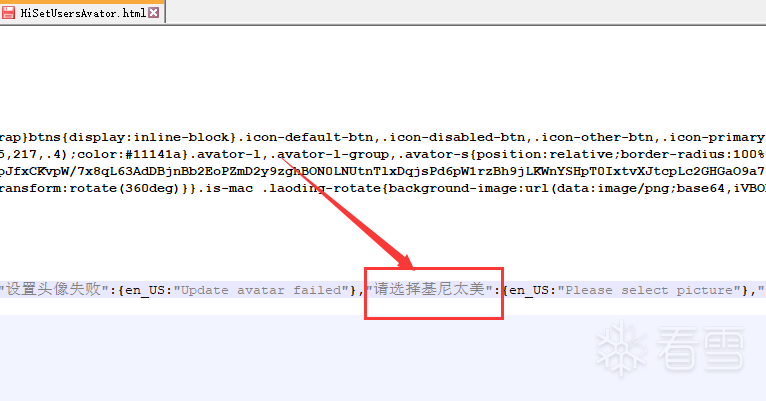
然后重新启动如流,登录,进入头像修改页面,结果直接给我乱码了。然后尝试了下啥也不改,只要是替换了,就会乱码。凉凉,估计加载资源文件的时候有校验,比如它的修改时间、MD5、编码等等。不过还是证明了修改文件会造成影响。
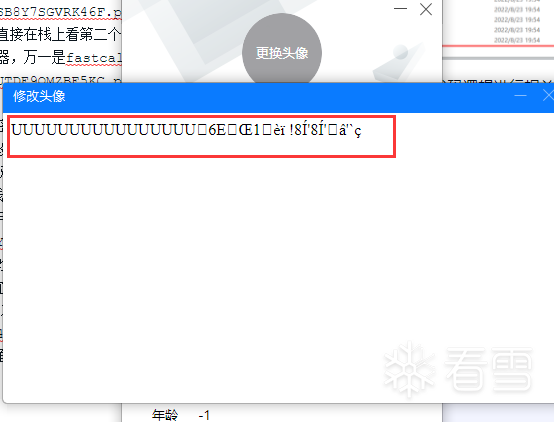
2.从内存里进行修改
五、开启CEF框架调试功能
在 cef_browser_host_t结构体中有一个show_dev_tools成员,可以用来开启调试窗口。
cef_browser_host_t对象可以通过cef_browser_t的get_host拿到,而cef_browser_t会在CEF的事件处理回调函数中作为参数传入,所以这里就要使用detours写hook代码了,去hook事件处理回调函数,代码如下:
|
1
2
3
4
5
6
7
8
9
10
11
12
13
14
15
16
17
18
19
20
21
22
23
24
25
26
27
28
29
30
31
32
33
34
35
36
37
38
39
40
41
42
43
44
45
46
47
48
49
50
51
52
53
54
55
56
57
58
59
60
61
62
63
64
65
66
67
68
69
70
71
72
73
74
75
76
77
78
79
80
81
82
83
84
85
86
87
88
89
90
91
92
93
94
95
96
97
98
99
100
101
102
103
104
105
106
107
108
109
110
111
112
113
114
115
116
117
118
119
120
121
122
123
124
125
126
127
128
129
|
/
/
dllmain.cpp : 定义 DLL 应用程序的入口点。
#include "pch.h"
#include "detours/detours.h"
#include "include/capi/cef_browser_capi.h"
#include "include/internal/cef_types_win.h"
#include "include/capi/cef_client_capi.h"
#include "include/internal/cef_win.h"
#include <Windows.h>
PVOID g_cef_browser_host_create_browser
=
nullptr;
PVOID g_cef_get_keyboard_handler
=
NULL;
PVOID g_cef_on_key_event
=
NULL;
void SetAsPopup(cef_window_info_t
*
window_info) {
window_info
-
>style
=
WS_OVERLAPPEDWINDOW | WS_CLIPCHILDREN | WS_CLIPSIBLINGS | WS_VISIBLE;
window_info
-
>parent_window
=
NULL;
window_info
-
>x
=
CW_USEDEFAULT;
window_info
-
>y
=
CW_USEDEFAULT;
window_info
-
>width
=
CW_USEDEFAULT;
window_info
-
>height
=
CW_USEDEFAULT;
}
int
CEF_CALLBACK hook_cef_on_key_event(
struct _cef_keyboard_handler_t
*
self
,
struct _cef_browser_t
*
browser,
const struct _cef_key_event_t
*
event,
cef_event_handle_t os_event) {
OutputDebugStringA(
"[detours] hook_cef_on_key_event \n"
);
auto cef_browser_host
=
browser
-
>get_host(browser);
/
/
键盘按下且是F12
if
(event
-
>
type
=
=
KEYEVENT_RAWKEYDOWN && event
-
>windows_key_code
=
=
123
) {
cef_window_info_t windowInfo{};
cef_browser_settings_t settings{};
cef_point_t point{};
SetAsPopup(&windowInfo);
OutputDebugStringA(
"[detours] show_dev_tools \n"
);
/
/
开启调试窗口
cef_browser_host
-
>show_dev_tools
(cef_browser_host, &windowInfo,
0
, &settings, &point);
}
return
reinterpret_cast<decltype(&hook_cef_on_key_event)>
(g_cef_on_key_event)(
self
, browser, event, os_event);
}
struct _cef_keyboard_handler_t
*
CEF_CALLBACK hook_cef_get_keyboard_handler(
struct _cef_client_t
*
self
) {
OutputDebugStringA(
"[detours] hook_cef_get_keyboard_handler \n"
);
/
/
调用原始的修改get_keyboard_handler函数
auto keyboard_handler
=
reinterpret_cast<decltype(&hook_cef_get_keyboard_handler)>
(g_cef_get_keyboard_handler)(
self
);
if
(keyboard_handler) {
/
/
记录原始的按键事件回调函数
g_cef_on_key_event
=
keyboard_handler
-
>on_key_event;
/
/
修改返回值中的按键事件回调函数
keyboard_handler
-
>on_key_event
=
hook_cef_on_key_event;
}
return
keyboard_handler;
}
int
hook_cef_browser_host_create_browser(
const cef_window_info_t
*
windowInfo,
struct _cef_client_t
*
client,
const cef_string_t
*
url,
const struct _cef_browser_settings_t
*
settings,
struct _cef_dictionary_value_t
*
extra_info,
struct _cef_request_context_t
*
request_context) {
OutputDebugStringA(
"[detours] hook_cef_browser_host_create_browser \n"
);
/
/
记录原始的get_keyboard_handler
g_cef_get_keyboard_handler
=
client
-
>get_keyboard_handler;
/
/
修改get_keyboard_handler
client
-
>get_keyboard_handler
=
hook_cef_get_keyboard_handler;
return
reinterpret_cast<decltype(&hook_cef_browser_host_create_browser)>
(g_cef_browser_host_create_browser)(
windowInfo, client, url, settings, extra_info, request_context);
}
/
/
Hook cef_browser_host_create_browser
BOOL
APIENTRY InstallHook()
{
OutputDebugStringA(
"[detours] InstallHook \n"
);
DetourTransactionBegin();
DetourUpdateThread(GetCurrentThread());
g_cef_browser_host_create_browser
=
DetourFindFunction(
"libcef.dll"
,
"cef_browser_host_create_browser"
);
DetourAttach(&g_cef_browser_host_create_browser,
hook_cef_browser_host_create_browser);
LONG
ret
=
DetourTransactionCommit();
return
ret
=
=
NO_ERROR;
}
BOOL
APIENTRY DllMain( HMODULE hModule,
DWORD ul_reason_for_call,
LPVOID lpReserved
)
{
switch (ul_reason_for_call)
{
case DLL_PROCESS_ATTACH:
InstallHook();
break
;
case DLL_THREAD_ATTACH:
case DLL_THREAD_DETACH:
case DLL_PROCESS_DETACH:
break
;
}
return
TRUE;
}
|
然后注入的话,我先是使用detours的注入功能:setdll /d:E:\VS_DEBUG\DetoursDll\Debug\DetoursDll.dll D:\infoflow\infoflow.exe
原理其实就是把dll给注入到exe的节表里了,运行失败,估计对exe有校验。
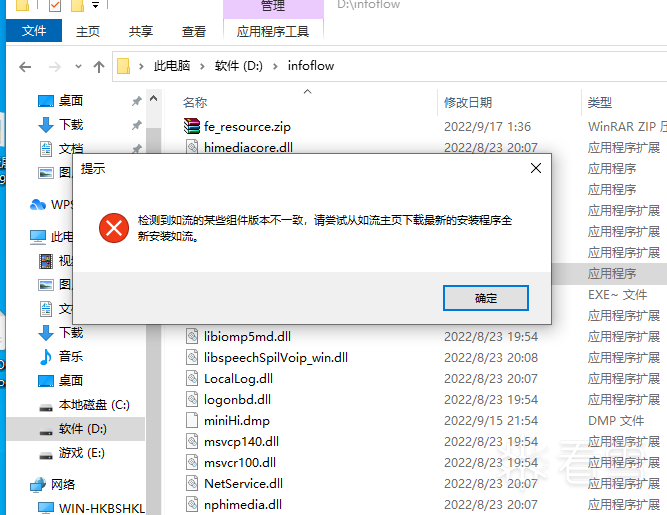
于是我在exe运行的时候,使用远程线程注入dll,成功。
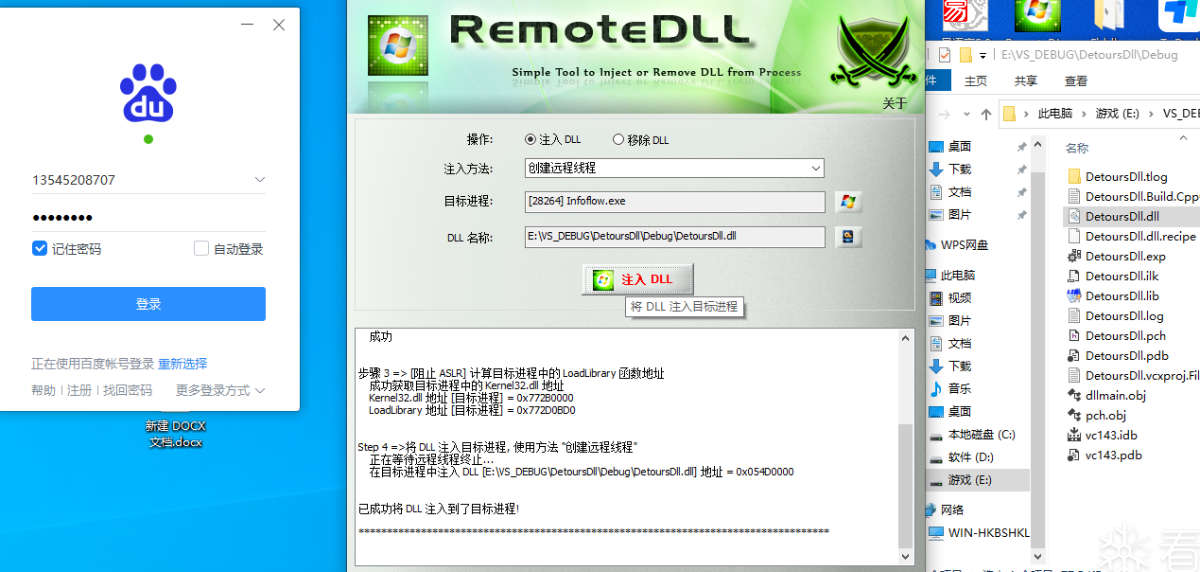
登录进去,尝试在某些页面里,按F12,可以开启Chrome调试窗口,非常的方便
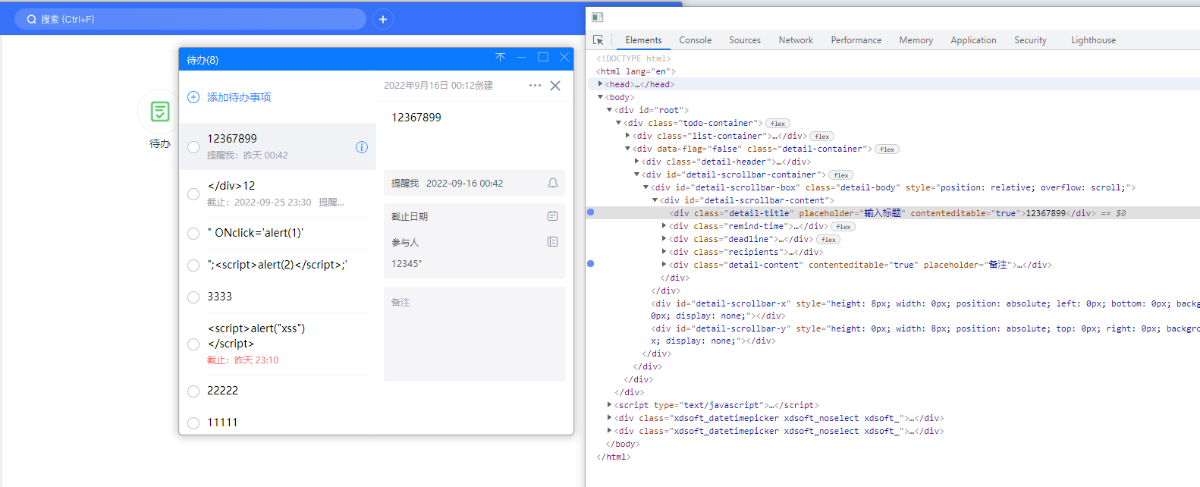
六、尝试做点什么功能+总结(未遂)
可惜的是,在聊天窗口里面,怎么按F12都不管用,资源文件里好像也确实没有聊天框相关的html,哎,本来想学着参考帖做一个防撤回工具的,结果聊天框压根就不是用前端语言写的,所以不能用CEF框架的调试功能去定位关键代码了。
但毕竟整了这么久,多少得干点啥吧,干脆在这里借用CEF框架,给大家普及一下XSS漏洞吧,嘿嘿。可以看到“待办”这个页面,可以进行一个输入、保存,通过Chrome调试页面可知,保存时,会将内容发送给服务器,那么如果我们去输入javascript脚本是否能触发xss反射型漏洞呢?
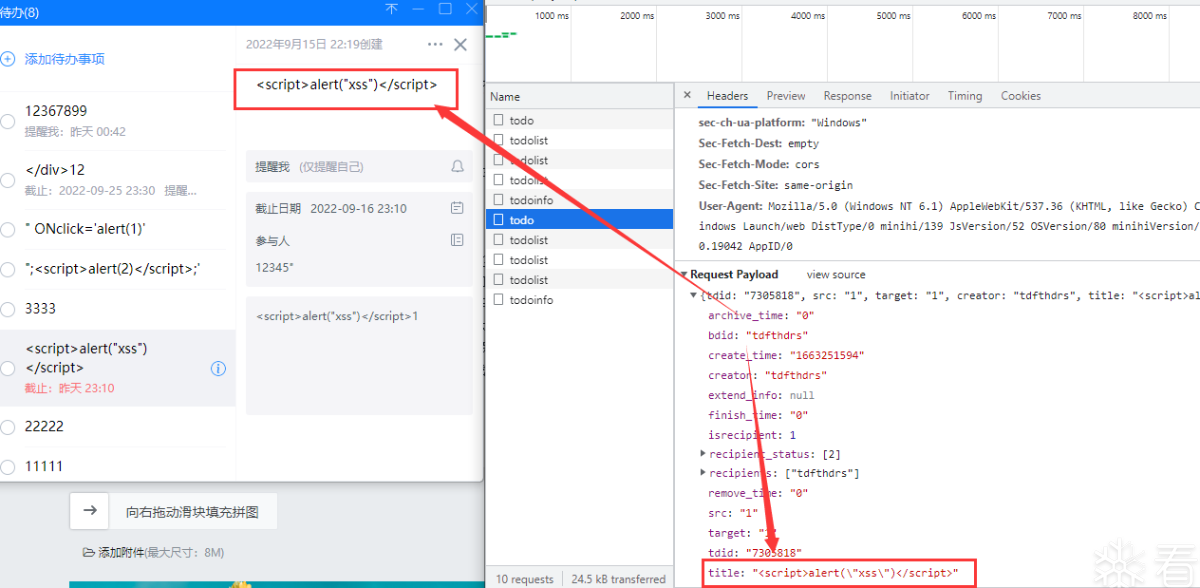
看了下页面元素构成,很明显不行,因为值是以文本形式夹在div标签里面,并不能触发脚本语言。

那好吧,我去找个存放在标签里面的值修改吧,可以看到,昵称是会写到value值下的

那我们把它改成攻击代码,将value用"给闭合,然后设置一个鼠标事件,当鼠标移动到框内时,就会弹窗。

结果并没有弹,查看html源码,发现"已经被编码成"

看来安全措施做的挺到位嘛,那我也就止步于此了~
总结下来,了解到了CEF框架的一些关键数据结构和api,达到解密资源文件的一个效果。然后也学会了detours的hook功能,使用静态或动态注入的手段。
更多【针对百度旗下的一个会议软件,简单研究其CEF框架】相关视频教程:www.yxfzedu.com
相关文章推荐
- 软件逆向-WinCHM 再探索! - 游戏基址二进制漏洞 密码应用智能设备
- 软件逆向-DTrace 研究 - 游戏基址二进制漏洞 密码应用智能设备
- 软件逆向-常见语言基础逆向方法合集 - 游戏基址二进制漏洞 密码应用智能设备
- 软件逆向-分享个东西,cheat engine的变速精灵(speedhack)模块调用方法. - 游戏基址二进制漏洞 密码应用智能设备
- 软件逆向-SoftAny WinCHM 5.496 注册码笔记 by ZeNiX - 游戏基址二进制漏洞 密码应用智能设备
- CTF对抗-crackme001 Acid burn - 游戏基址二进制漏洞 密码应用智能设备
- Android安全-定制bcc/ebpf在android平台上实现基于dwarf的用户态栈回溯 - 游戏基址二进制漏洞 密码应用智能设备
- CTF对抗-Java安全小白的入门心得 - 初见RMI协议 - 游戏基址二进制漏洞 密码应用智能设备
- 编程技术-这个崩溃有点意思,你中过招吗 - 游戏基址二进制漏洞 密码应用智能设备
- 软件逆向-PE头解析-字段说明 - 游戏基址二进制漏洞 密码应用智能设备
- 软件逆向-PE加载过程 FileBuffer-ImageBuffer - 游戏基址二进制漏洞 密码应用智能设备
- 加壳脱壳-进程 Dump & PE unpacking & IAT 修复 - Windows 篇 - 游戏基址二进制漏洞 密码应用智能设备
- CTF对抗-第五空间 crackme深度分析 - 游戏基址二进制漏洞 密码应用智能设备
- Pwn-DAS9月月赛PWN题出题心路 - 游戏基址二进制漏洞 密码应用智能设备
- CTF对抗-CSAW-CTF-Web部分题目 - 游戏基址二进制漏洞 密码应用智能设备
- CTF对抗-2022MT-CTF Re - 游戏基址二进制漏洞 密码应用智能设备
- 编程技术-逆向IoRegisterPlugPlayNotification获取即插即用回调地址,配图加注释超级详细 - 游戏基址二进制漏洞 密码应用智能设备
- 软件逆向-针对百度旗下的一个会议软件,简单研究其CEF框架 - 游戏基址二进制漏洞 密码应用智能设备
- Android安全-逆向篇三:解决Flutter应用不能点击问题 - 游戏基址二进制漏洞 密码应用智能设备
- Android安全-Android - 系统级源码调试 - 游戏基址二进制漏洞 密码应用智能设备
2):严禁色情、血腥、暴力
3):严禁发布任何形式的广告贴
4):严禁发表关于中国的政治类话题
5):严格遵守中国互联网法律法规
6):有侵权,疑问可发邮件至service@yxfzedu.com
- react.js-Antd React Form.Item内部是自定义组件怎么自定义返回值
- 区块链-2023年A股借壳上市研究报告
- spring-Spring Boot中处理简单的事务
- 网络-【hcie-cloud】【4】华为云Stack规划设计之华为云Stack标准组网【中】
- 华为云-基于STM32设计的智能水母投喂器(华为云IOT)
- 缓存-【Redis】list常用命令&内部编码&使用场景
- pdf-PDF有限制密码,不能复制怎么办?
- objective-c-【Objective-C】Objective-C汇总
- node.js-npm切换镜像源
- github-Jekyll框架编译GithubPages,提示没有docs